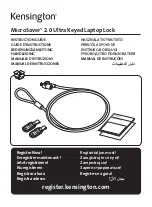
Drawing Number: 21075
Revision: C
ECN Number: 47023
OPERATION MANUAL FOR
QUARTZ PRESSURE SENSORS
SERIES 102
SERIES 113
3
5.0
POLARITY
The sensors in this series produce a positive-going
output voltage for increasing pressure input.
6.0 LOW-FREQUENCY RESPONSE
The low-frequency response of an ICP
®
system is
determined by:
1.
The discharge T.C. of the sensor
2. If AC-coupled at power unit, the coupling time
constant.
Consult Section 7.0 in guide G-0001B detailed
explanation of low-frequency characteristics of ICP
®
instruments.
7.0
HIGH-FREQUENCY RESPONSE
Frequency tailoring and the very high-natural
frequency of the sensor give an extremely wide
usable
frequency
range
(beyond
100
kHz).
Exceptionally fast response time (1 µsec) and clean,
virtually non-resonant response to rapid step
functions are also features of these sensors. As
mentioned previously, the diaphragm must be flush-
mounted to fully realize the high-frequency response
capabilities of this series.
8.0
CALIBRATION
Piezoelectric sensors are dynamic devices, but static
calibration means can be employed if discharge time
constants are sufficiently long. Generally, static
methods are not employed below several hundred
seconds time constant.
To employ static means, direct couple the sensor to
the DVM readout using a T-Connector from the
sensor jack or use the Model 484B in the calibrate
mode. Apply pressure with dead weight tester and
take readings quickly. Release pressure after each
calibration point.
For the shorter time constant, rapid step functions of
pressure are generated by a pneumatic pressure pulse
calibrator or dead weight tester and readout is by
recorder or storage oscilloscope.
PCB offers a complete calibration service. Consult
factory for details.
ICP is a registered trademark of PCB Piezotronics



























